Contents
Privet is described as a whole genus of shrubs and small trees that grow in Europe, Asia, as well as in North Africa and Asia. The photo and description of the privet shrub are similar to the lilac known in Our Country. This is not surprising – plants are close relatives. Plantings of this genus are widely used in landscape design. They can easily be given almost any shape, but in an uncut state, the shrub looks very untidy. Privet evergreen is more popular with landscape design professionals.
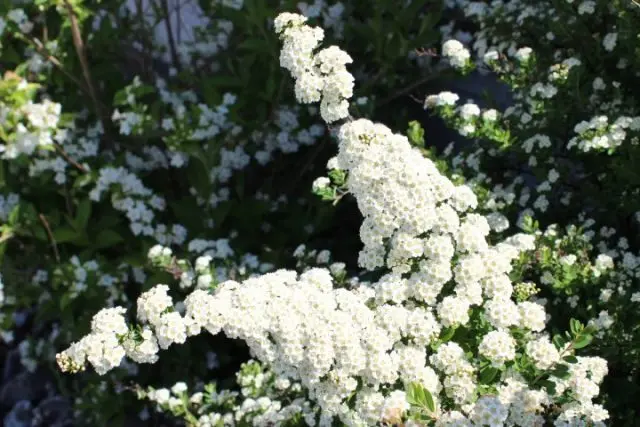
Description of privet
This genus includes deciduous and evergreen varieties of shrubs and small trees. More than 50 species of privet are known from descriptions. It is unpretentious in care, grows well in the shade, and therefore has become widespread in landscape design. Most often, the shrub is used as a hedge.
privet leaves
The description of the leaves of the shrub states that they are small in size. The surface is leathery and glossy. The leaves are oval in shape, up to 6 cm long. The shrub, depending on the variety, can shed its leaves during the cold period or remain evergreen. There are also mixed types, when the plant partially sheds foliage.
privet blossom
The flowers of an ornamental shrub are white, collected in panicles. The aroma during flowering is strong, but pleasant. After flowering, fruits are formed. Flowering begins in early June. If the climate is warm, then flowering may begin a week or two earlier. The whole period lasts three months. Blooming privet will always attract attention with aroma, but in some varieties it is too harsh.
During the period when flowers form on the shrub, they become especially decorative and pleasant in appearance. The description of the shrub compares its flowers to snow that covers the branches to the very top.
privet berries
The fruits are bluish-black. They remain on the shrub during the winter. The fruits are popularly known under the name “wolf berries”. Each berry contains from 1 to 4 seeds, the fruits themselves are round in shape.

privet height
Height from one and a half to three meters, depending on the specific species. There are dwarf varieties that are 60–100 cm high. The height can be adjusted by trimming. The main advantage of privet is that it can be given absolutely any shape by trimming: a ball, a cone, a pyramid.
Poisonous or not privet
The berries and leaves of the shrub are considered poisonous. Both humans and animals can be poisoned. The berries contain tetroid glycosides, which cause poisoning, especially when consumed in large quantities. At the same time, the bark and some other parts of the shrub are used for medicinal purposes. But it is important to know the exact recipe and use it strictly according to the recipe. The fact that privet is poisonous is important to remember for those who have small children in the family so that decorating the site is not dangerous for them.
The main symptoms of poisoning are colic, weakness, diarrhea. Then loss of coordination of movements and convulsions is possible. In many cases, death is possible.
Privet in landscape design
The privet shrub is found in many landscape design photos. It is used by both professionals and amateurs to decorate areas. There are many pictures of privet on the stem, as well as in sculptures. The shrub looks great in single plantings and in group compositions. Its use in hedges is popular. The species variety allows you to choose a shrub of such a height that will be optimal for the owner of the site. This plant is characterized by its use in topiaries, as well as in alpine hills at an average height. Privet as a fence is found everywhere.

Types and varieties of privet
A huge number of varieties allows you to choose exactly your own, suitable decor for every taste. For lovers of evergreen decorations, there are varieties with non-falling leaves that will delight the eye even in winter. The types of privet differ in size, spreading crown, length of inflorescences and other parameters.
privet golden
This variety is considered one of the most sought after in landscape design. This is a variety of Japanese or oval-leaved shrub. The plant belongs to semi-evergreen, that is, the foliage on the shrub falls partially. The leaves are bright in color, the shrub looks beautiful even in winter. It grows well in any conditions, does not like wet soil. He loves light, and therefore it is better to choose a lighted area with a minimum of shadow. The leaves are glossy, oval in shape, 6 cm long. The leaves have a golden edging along the edges.
The bark is grayish brown. The berries are black, glossy, poisonous to humans. Golden privet calmly tolerates winds, and therefore it is not necessary to plant it on weathered slopes.

Privet shiny
Privet brilliant grows in China, Korea, Japan. This shrub has the appearance of a compact tree. The front side of the leaves is glossy, the leaves themselves are 15 cm long. The length of the inflorescences is 18 cm. The shrub blooms for three months. This is one of the most frost-resistant varieties that perfectly tolerate frosts of -15 ° C. But with a greater drop in temperature, you will need to cover the bush so that it survives a too cold winter.
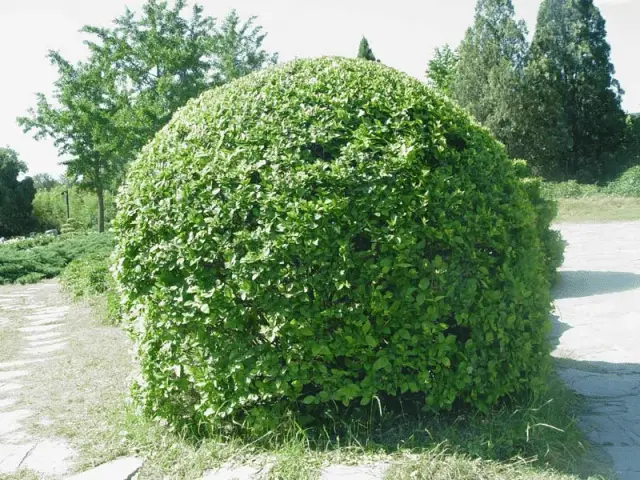
Privet variegated
This is a type of Chinese privet. A characteristic feature is the leaves are long, pointed and with golden fields. Yellow privet flowers appear in autumn. The shrub blooms in white with a creamy tint. It has a very pleasant aroma during flowering. But for the first time, the shrub will delight with flowers only 3 years after planting. This variety of privet also likes a lot of sunlight, and for its planting it is required to choose a lighted place with a minimum of shade. One of the fastest growing varieties of shrubs, reaching a height of two meters. Often used as a hedge.
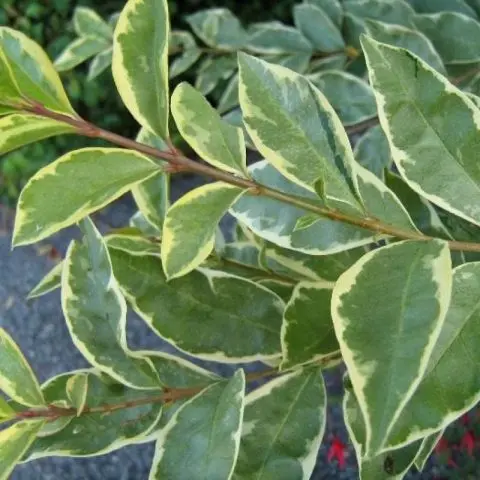
Privet Japanese
This variety is found naturally in Japan and Korea, hence the name. In Japan, it is used for ikebana. Grows up to four meters in height. But in nature it can grow up to 8 meters, but the distinguishing feature is that this tree grows slowly. The crown is compact and dense. This shrub is easy to give any shape. Small dark green leaves. Japanese privet has high cold resistance parameters, so it grows well in many regions of Our Country. The flowers of the Japanese variety are white, but the smell is not very pleasant.
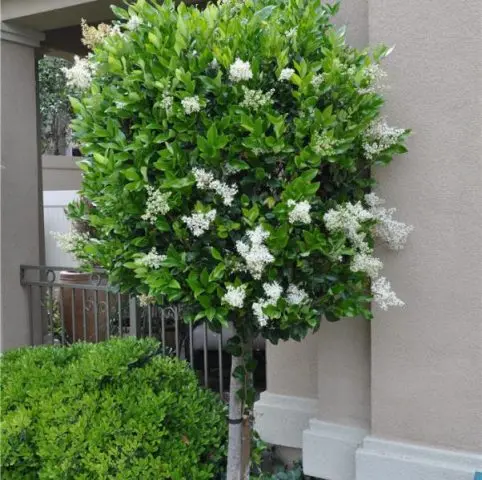
Sinense primrose
Small shrub native to China. This is a variety of common privet. In the conditions of Central Our Country, it grows up to two meters, no more, although in a warmer climate this beautiful shrub can grow up to 5 meters. Frost-resistant, because in winter it withstands short-term frost down to -30 ° C. But Sinensa can withstand such frosts only for a short period. If the winter is too frosty, then the shrub will have to be covered.
In landscape design, this type of privet is used as a low hedge, in topiary sculptures, in the form of balls, squares and other shapes.
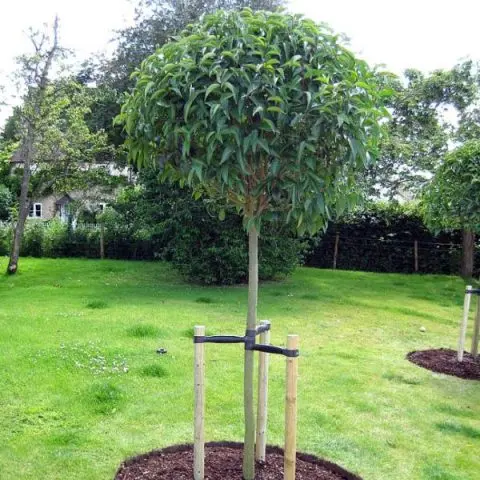
Privet Argentum
Ligustrum privet cultivar Argentum is a wonderful plant. It blooms in June-July, and grows up to about one and a half meters. It tolerates diseases and pests well, and also cuts easily and beautifully. The shrub got its name for the color of the leaves, which seem to be powdered with white snow.
The variety is drought-resistant, perfectly tolerates rare watering. Does not like too wet soil.
Lilac atrovirens
This is a common variety of common privet. It blooms from June to July, but the white flowers have a too pungent smell. The shrub has straight shoots. It is a semi-evergreen shrub that grows up to 4 meters in height. The leaves are glossy, dark green, changing to purple-brown in winter. But in the spring these leaves fall off. The fruits are black, shiny with a few seeds. In general, the plant is considered unpretentious, but the shade is not always tolerated well.
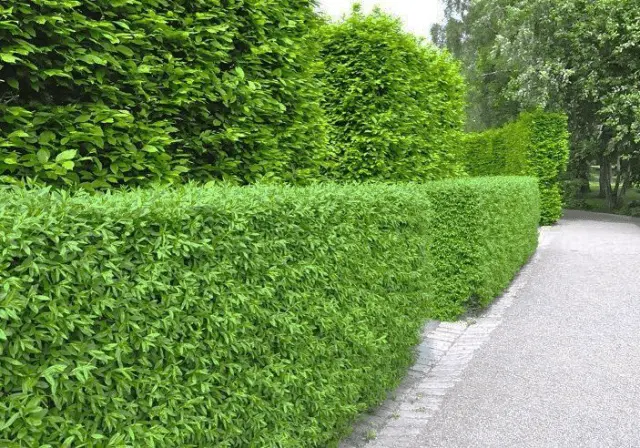
Privet Molodushka
This variety is a deciduous shrub. The crown is rounded up to 5 meters in height. The branches of the shrub are thin, curved. Inflorescences are collected in panicles up to 20 cm long. The flowers are white, the aroma is pleasant. Shrub blooms later than other varieties at the very end of summer and early autumn. Fruits are glossy, black-purple, ovoid. Dislikes damp, clay soils. Poorly tolerates frosty winters, loves heat, but at the same time drought-resistant. If it freezes over in winter, it usually recovers easily in spring. Grows fast and tolerates shearing well.
Planting and care
In order for an ornamental shrub to please the eye of the owner for a long time and decorate the site, you need to properly plant and care for it. It is important to choose the optimal landing time and place. The site may depend on the species, but the general conditions of care are almost the same, and there is no huge difference in watering and pruning for different species. Shearing in care is a mandatory aspect, because otherwise the shrub will look very messy and unkempt.
Rules of landing
Garden privet is a cultivated plant, and therefore, when planting, you need to choose and prepare a place. First of all, you need to choose a place. The shrub is not afraid of the winds and can grow in the shade. As for the soil, privet is not capricious, but it is better not to grow it on acidic, sandy and dry soils or add a more nutritious mixture. When choosing a place, it should be noted that the shrub should be a meter from the nearest trees or buildings.
It is optimal for planting to prepare the following mixture: 2 parts of humus, 3 parts of turf, 1 part of sand. Planting is best done in the spring, before the buds open. But in the fall, planting of privet is also allowed. It is important that she has time to take root before the first frost.
The hole for planting is 65 cm wide and 35 cm deep. More precisely, the depth should be determined by the type of seedling roots. The hole should be slightly deeper and wider than the root system. Pour water into the bottom of the dug hole, and then pour a layer of rubble for drainage. The layer thickness is 20 cm. It is better to add nitroammophos to the prepared nutrient composition and pour a small amount into the hole, preferably with a mound. From above, carefully straightening the roots, install a seedling. Then pour in the rest of the nutrient mixture.
According to the rules of planting, within 30 days after planting, the land around the seedling should not dry out, and then mulch is laid there, most often peat. Straw can also be used for mulching.
For the manufacture of hedges, it is recommended to plant seedlings not in holes, but in trenches. The distance between the bushes is 40 cm. This is the optimal parameter to make the hedge the desired density.

Watering and top dressing
Most privet varieties tolerate drought well and do not like waterlogged soil. Therefore, it is not recommended to water the shrub too often. If there is enough precipitation in summer, then watering is not needed at all. If the summer is dry, then you need to water rarely, but enough. Under each bush it is supposed to pour at least three buckets of water. At the same time, four such irrigations are enough per season.
The plant needs feeding in the spring. It must be organic fertilizer. It is enough to add a bucket of humus or compost under each bush. If ornamental trees and privet shrubs are used in hedges, then fertilizers should be distributed under each bush. From above, you can add superphosphate in granular form. Top dressing is sprinkled with earth, be sure to water the seedling.
Loosening and mulching
The top layer of the earth must be loosened regularly. So air is better supplied to the roots, less shrubs are exposed to diseases, especially those associated with high humidity. Initially, when planting, the earth must be dug up well so that it is soft and loose.
Mulching helps to retain moisture, protects the plant from frost. Therefore, it is imperative to mulch the privet a month after planting and in the fall, before winter frosts.
Trimming
Pruning is the most important aspect of privet care. This ornamental plant belongs to the fast-growing, and therefore formative pruning is necessary regularly. Unlike many other ornamental shrubs, privet should be cut right in the planting year. This first pruning consists of trimming the tops of the shoots.
When the shoots grow by 15–20 cm, they are shortened again. This will make the shrub more lush. Pruning will be needed during the first two years of the shrub’s life.
Pruning of privet hedges is carried out twice a year – in May and August. As with all plants, privet is important for sanitary pruning, which is carried out in order to remove diseased and frostbitten branches. This haircut is carried out in early spring. After removing all diseased branches, the remaining shoots are cut off by another third.

Preparation for winter
Relatively warm winters are easily tolerated by privet. Some varieties are able to withstand severe frosts. It is important to prepare the shrub for wintering so that during sanitary pruning you do not have to cut half a bush in the spring. In preparation for winter, you need to mulch the plant. It is optimal to do this with peat or straw. Layer thickness – 15 cm. As soon as enough snow falls, it is recommended to bend the maximum number of branches to the ground and sprinkle them with snow. Under a thick snow cover, it is more likely to avoid freezing of shoots.
Privet breeding
The privet shrub reproduces in several ways:
- seeds;
- layering;
- cuttings;
- root suckers.
The most time-consuming process is considered to be the process of growing decorative privet from a seed. Therefore, propagation by cuttings and layering is more popular methods. But each method has a large number of its advantages and disadvantages, so amateur gardeners choose the propagation method to their liking. But it is better to know all the breeding techniques.
Propagation of privet cuttings
The most used method, because it is simple and accessible. Cuttings cut in summer are best rooted. For this, not only young shoots are suitable, but also healthy last year. There are practically no problems with them. The optimal length is 10–12 cm. A cutting is planted for rooting in soddy soil with a sandy surface. The cutting is planted in the ground at an angle of 45 degrees. It is enough to insert a cutting 5 cm deep. For high-quality rooting, you will need constant humidity and a temperature of 20–25 ° C. To create good conditions, many gardeners use plastic bottles without a neck, which are covered with cuttings. The very first roots appear within a month, and 90 days after planting, the cutting has an already developed root system. Then the cuttings can be transplanted into a larger dish and grown until the height is 60 cm. Only after that can the seedlings be safely sent to a permanent place in the garden.
Layers
This is less troublesome than growing cuttings. Almost all varieties of privet can be propagated by layering. The algorithm of actions is simple:
- Choose the strongest branch, bend to the ground.
- In the part that will be buried, a small incision should be made.
- Commit branch.
- Sprinkle with soil, pour sphagnum on top.
- Do not bury the top of the branch.
- Moss should always be kept moist.
If the layering takes root, the shrub branch will grow. This is a sign that rooting was successful. You can separate and plant layering of shrubs next spring.
If there is no desire to engage in digging, then it is enough to just make a couple of scratches on the branch and place this part in a plastic bag with moistened and nutritious soil. Seal or seal the package. Using this original method, you can immediately get several layering from one bush.
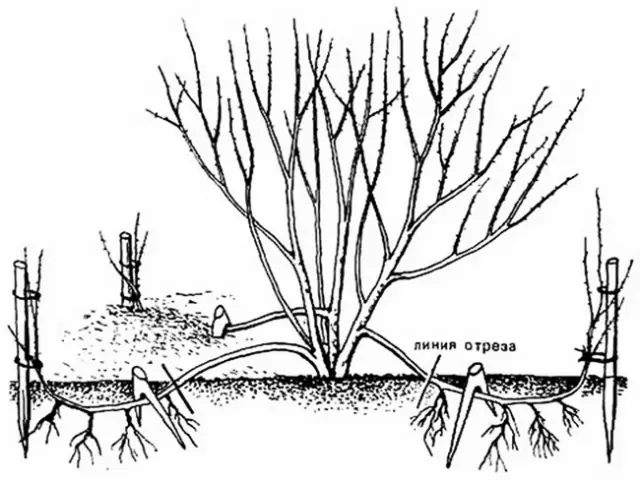
Seeds
It is immediately worth noting that privet seeds have a low percentage of germination. That is why this method is considered too time-consuming, costly. But this method also has fans. Seeds can be collected from fruits that appear after 6 years of shrub life.
For propagation by seeds, it is necessary to select the largest ones, place them in water. Only seeds that will sink should be left for reproduction. In autumn, in October, the seeds are placed in the ground so that only the strongest specimens remain in winter. Exactly one year later, the first shoots will appear.
Diseases and pests
Privet and all varieties of shrubs are plants that are not susceptible to almost any disease. Of the diseases for shrubs are dangerous: powdery mildew, grayish or dark green spotting. Usually the appearance of such pathologies indicates an increased acidity of the soil. It is enough to treat the plant with special preparations in time, and remove diseased shoots.
Pests that often appear on the bush:
- aphid;
- thrips;
- spider mite;
- scale shield.
To prevent the appearance of pests, it is necessary to treat the shrub with complex pest preparations twice a year.
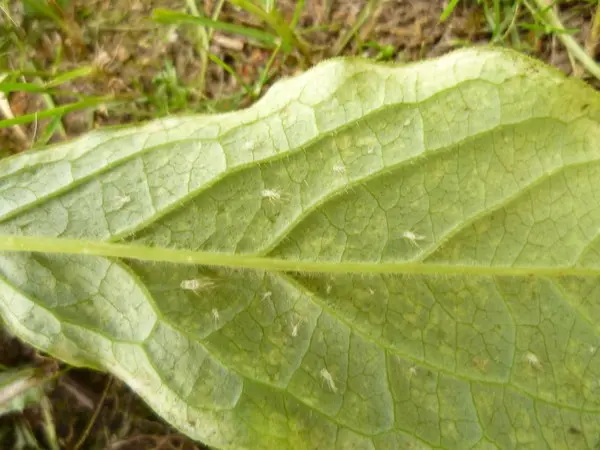
Conclusion
The photo and description of the privet shrub are few known, since this plant is known to everyone as a wolfberry among the people. But this is a chic ornamental plant that can decorate any area. Privet is used in the art of bonsai, and Ikebana is made from it in Japan. In Europe, fences and hedges are formed from privet in many areas. But even in single sculptures, this plant can often be found. It is convenient to cut it, it grows quickly, is unpretentious in care, and is not subject to a large number of diseases. Therefore, he has more and more fans every year.









